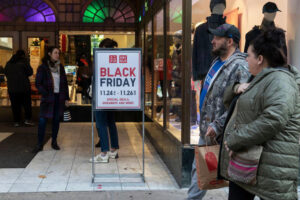NOVEMBER 26, 2023

Retailers aren’t just having trouble getting shoppers to buy sweaters and other holiday items this season. Store credit cards are also a tougher sell.
The cards, which typically can only be used at a particular chain, have been a lucrative source of revenue for retailers as merchandise sales have slowed. But the stream is drying up as Americans carry fewer cards and increasingly finance purchases with buy now, pay later providers. Interest rates surpassing 30% on some retailers’ credit cards aren’t helping, according to analysts.
The payment shifts add to the challenges many retailers face this holiday shopping season as they look to clear out inventory and preserve profits.
So far there are signs that U.S. shoppers are shelling out cash on gifts and other items. More shoppers visited stores and online spending grew on Black Friday this year compared with last year, according to third-party analytics firms.
U.S. retail sales on Black Friday rose 2.5% from last year, according to Mastercard SpendingPulse, which measures sales in stores and online. The result was helped by gains in sales of jewelry and apparel as well as spending on sporting events and at restaurants.
About 182 million people are expected to shop online and in stores between Thanksgiving and Cyber Monday, according to the National Retail Federation, a trade group.
Offered by retailers from Neiman Marcus to Target, store-branded, or private-label credit cards as they are sometimes called, have suffered from the yearslong shift to e-commerce and the temporary store closures during the Covid-19 pandemic. That is because most customers open such accounts at cash registers inside bricks-and-mortar stores.
Private-label card originations fell 37% last year compared with 2015, according to the Consumer Financial Protection Bureau. Over that period, originations of general purpose credit cards grew 33%. Revolving balances on private label credit cards and general credit cards are moving in a similar pattern.
The CFPB concluded in a recent report that the decrease in private-label originations was likely due to less consumer demand.
Rising interest rates have made store cards—which tend to charge higher rates than traditional cards—even less attractive for consumers. The average interest rate for retail cards is 28.93%, compared with 21.19% for all credit cards, according to Bankrate.com, a personal-finance website.
“The number of store cards in circulation has fallen off a cliff,” said Ted Rossman, senior industry analyst at Bankrate.
Retailers are bracing for more hits to credit-card revenue. The CFPB has proposed a rule to cap late fees for missed monthly payments at $8, compared with $41 currently. If adopted, the cap could save American families as much as $9 billion a year in late fees, according to the CFPB. The rule would apply to all credit cards, not just store cards.
Jill Timm, finance chief at Kohl’s, told analysts this month that the retailer was working on ways to mitigate any reduction in late fees. Kohl’s recently launched a co-branded card with Capital One Financial that consumers can use at a variety of merchants in addition to Kohl’s. The co-branded card relies more on interest from revolving balances, she said.
Retailers have been trying to make their store cards more attractive by tying card use to loyalty points and giving cardholders other perks such as free shipping. Shoppers who spend $250 on their JCPenney credit card in bricks-and-mortar stores Dec. 1 through Dec. 24 will have an option to pay off those purchases interest free in six equal monthly installments. Shoppers who are enrolled in Kohl’s loyalty program and pay with their Kohl’s card earn 50% more rewards on each purchase, the company said.
Many retailers have sold their credit- card receivables to banks but continue to earn profits from interest charges and other fees. Card revenue is highly profitable, according to Stacey Widlitz, president of SW Retail Advisors. “Every piece that is chipped away is painful,” she said.
Loyalty is less of a draw than it once was, particularly with rising prices. More U.S. consumers switched retailers in 2022 than at any time since the beginning of the pandemic as they sought out value, according to a recent McKinsey report.
Emma Fortuna, a 25-year-old publicist, said she doesn’t have store credit cards because she doesn’t shop enough at any one retailer to make them worthwhile. Instead, the Charlotte, N.C., resident uses buy now, pay later services for online clothing purchases. She puts everything else on her Visa card to consolidate rewards points.
Income from Target’s credit-card business declined 10% in the most recent quarter, compared with the same period a year earlier. At Kohl’s, other revenue, which includes credit cards, was down 6%. Macy’s credit-card revenue dropped 31%.

Macy’s Chief Executive Jeff Gennette said in an interview that only a small portion of its customers use buy now, pay later and attributed the recent decline in card revenue to rising delinquency rates that are reverting to prepandemic levels. He added that the overall portfolio is healthy.
While buy now, pay later options are still nascent, they are growing. The practice is a modern take on old-fashioned layaway plans and lets shoppers get the goods up front but make interest-free payments over time, usually in four installments over six weeks.
Instead of earning a profit from customers who keep balances on their store cards, retailers pay fees to the financial-technology companies that offer buy now, pay later plans, including Klarna Bank, Affirm Holdings and Afterpay. Overall, the services are still a small part of spending; they accounted for 7.6% of all online sales from January through October.
Some store cards charge annual percentage rates above 30%, including Michaels Stores, Burlington and Academy Sports + Outdoors. Store cards tend to charge higher interest because they are less selective when it comes to credit quality, Bankrate’s Rossman said. He added that 30% used to be a barrier that few card issuers dared to cross.
Michaels Stores, Burlington and Academy Sports didn’t respond to a request for comment.
Some lawmakers have called for caps in annual percentage rates at 18% as U.S. households’ credit-card debt has topped $1 trillion for the first time. Groups of credit-card issuers have said that the 18% cap would restrict the availability of this type of credit for some consumers.
Alex Capozzolo, a 31-year-old real-estate investor, has store cards from Home Depot, Target and Crate & Barrel, but he doesn’t want any more. “They are hard to keep track of,” said the San Diego resident. “I don’t want to risk missing a payment and owe all that interest.”
Courtesy: TWSJ

































































































